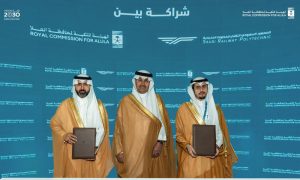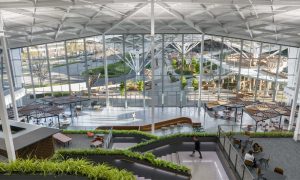Magic Kingdom – The outlook for Saudi Arabian construction
David Clifton of Hill International takes an in-depth, exclusive look at the Kingdom’s construction industry for 2022 as it looks to deliver on its ambitious plans for the country

Closing the door on another slightly challenging year for the industry, 2022 offers further growth opportunities as the economy continues to recover from the pandemic. 2021 produced a significant bounce back for all of the GCC economies, although in terms of recovery to the levels last seen in 2019, we are still some way off.
The outlook for Saudi Arabia in general looks to be positive and this is driven in no small part by the construction industry, which is a significant contributor to the economy. And with an ‘under construction’ and ‘in the pipeline’ total of almost $1.2 trillion – of which c.$735 billion are in pre-contract, there are reasons to have a positive outlook for the short- and long-term future of the industry.
As with every country globally to impact in 2020 was incredibly significant to economic output. At this time, it is challenging to see how the Kingdom will return the 2018/19 level of GDP output given the growth forecasts. The current expectations could be outstripped by a sustained high oil price. Although cognisance needs to be taken that outside of OPEC+ the USA shale oil productions comes on stream and profitable at between $50-55 per barrel.
This should mean that with a budget of 1.045 trillion Saudi Riyals that fiscal balance is restored to the country outgoings. Given that Saudi Arabia also historically undershoots fiscal spending commitments (as a rule, not always), stability is expected in the government finances in 2022. Although this should be caveated that the current government expectation of growth in 2022 is 7.5% and our modelling suggest closer to 3% based on historical norms.
The last four years have been quite phenomenal in the Kingdom – for consultancy houses. It is telling that the rest of the supply chain have yet to see the downstream benefits of the programmes that the country is embarking on.
This is showing distinct signs of changing, although there are issues the industry must address in 2022 and beyond that we will highlight accordingly.
The next two years are expected to present significant challenges in the construction sector in KSA with imbalances and price volatility in the materials market as well as logistics – both in terms of costs and timings – in conjunction with the intent of the government to accelerate the materialization of the delayed mega projects.
International Enthusiasm
Whilst many of the international supply chain organisations are interested in KSA to a greater or lesser extent, there are the historical issues that the Kingdom has presented to the market – most significantly the main contractor supply chain.
The primary problems for engagement stand around fair and amical contracts, payment schedules, fair assessment of variations and payments of invoice sections not disputed when a submittal is issued. This makes engagement or reengagement challenging as the burden of trust will have to fall to the client body. This is quite separate to the complexity, location and thus the logistics addressed later for these schemes. Essentially, the possibilities are significant, although the risks are considered large.
Inflation
As we’ve seen subsidies reign in or disappear in certain areas of the economy (e.g., fuel, electric and water), we have seen inflation average 3.6% in 2021, although the year commenced with up to 6% per month in Q1. We expect to see a more balanced inflation curve in 2022 as supply and demand starts to meet a greater level of parity.
Within the construction industry, we have seen inflation of c.7.5% in 2020 driven by a global material price surge of 32.5% year on year. The factors behind this being related to the supply and demand as businesses cut furiously in the pandemic to survive (the pandemic was different from the global financial crisis in that every country and sector partially closed, slowed down or shut down).
The estimated range for expected inflation in 2022 and 2023 is 1.6%-2.8% and 2% -3% respectively. Clients and supply chain will need to be mindful of any ‘hype’ on project awards overheating the market. This is currently an unlikely scenario (as mentioned elsewhere), but dangers associated with the lessons learnt of Dubai in the mid-2000’s and counterproductive procurement models should be in mind.
If we just take rebar as an example, we ended 2021 with prices 72% up for landed goods compared to the start of 2020. This is certainly driven by China’s demand – dominating the demand side with 56% market share.
However, for 2022, we do see a softening of the futures market as prices decline due to major factors surrounding a China economic slowing and supply coming back swiftly on stream. This is evident across most other material price points.
As an outline forecast for 2022, we expect:
- Concrete prices normalise in 2022 and 2023 to c.2.5-3% per annum increases as local contract awards recommence their trend towards a historically normal level.
- We do not forecast steel sections to decrease significantly in 2022 and 2023.
- We expect cabling prices to stabilize in 2022 as metal input prices level off and start to decrease thereafter.
- Labour inflation is expected at c.2% in 2022, based on potential scarcity. We don’t expect blue collar salaries to pick up, although white collar roles will see some upward trends based on skill sets.
As an industry 2022 inflationary pressure will be muted slightly by supply adjustments and clients already looking to lock in delivery capacity and supply at a certain price point, although we would expect construction to trend at a similar inflation level to wider economy.
Industry Compound Annual Growth Rate (CAGR)
Our assessment of the CAGR in the industry is c.5-6% for 2022 which is tempered against more bullish estimates due to a variety of factors that drive the modelling.
Firstly, there is a level of capacity constraint. The industry has seen the workforce (blue and white collar) in the Kingdom has contracted from 3,541,997 at the end of 2017 to 2,029,594 at the end of 2020. A loss of 42.5% of the workforce (source General Statistics Authority). This is as a direct result of declining back log and pipelines in recent years, workers have been repatriated and this will take time to ramp up.
Secondly, constraints exist around the skill sets required to deliver some of these ambitious schemes and scarcity of individuals and products to deliver. As major projects have started to wind down from peak load, skilled individuals have departed. Furthermore, because of the lack of overtly complex or mega sized projects being awarded in the past few years, larger, more complex companies in the supply chain don’t have the scale to service the market expansion as small, lower cost organisations have taken larger market share.
Thirdly, finance for the supply chain to ramp up should businesses wish to expand. The banking system has large exposures to the industry as a whole and with payment issues historically tying up supply chain cash, there needs to be an appetite to provide working capital or clients will have to increase mobilisation payments to ensure the ability to service their project/s.
Contracting Awards
Over the course a prolonged period (7-8 years), Government sector direct contracts have typically made-up c.$20-25 billion of contracting awards in the Kingdom. The variations which typically move the awards into the $30-35 Billion range are the semi government and private sector.
There are major anomalies that occur at periodic times. These mega projects are often from the Oil and Gas sector, although major infrastructure such as Riyadh Metro cause significant increases in the awards structure.
As noted previously, there has been a fall off in project awards since 2015, with the exception of a major deviation in 2019. In relation to manpower decreasing, but contribution of the industry to GDP holding a level of resiliency, we look to the project types. Labour intensive projects have waned, whilst machine and technology heavy projects have more or less continued. This is especially notable in the Oil and Gas sector.
Moving into 2022, we see awards pickups to c.$35.6 billion which supports the CAGR forecast and contribution to GDP expectations. If all projects currently committed to be awarded in 2022, we would see an anomaly of over $50 billion in capital value, but historical trend analysis indicates this is unlikely due to a variety of constraints such us funding commitments, ‘red tape’ related to awards and unrealistic time frames for tender, negotiation and award.
Funding
Financing projects and attractive investors is critical to achieve or challenge the forecast CAGR. At this time, Foreign Direct Investment (FDI) is lagging behind the hoped for $100 billion by 2030 with only $5.5. billion in 2020 (compared to a target of $19 billion) and $1.4 billion into Q2 2021.
Having noted the challenge on FDI though, there is inherent interest from several foreign Export Credit Agencies (ECAs) to look at capital deployment or guarantees to support their export market and continue to build the political ties other G20 countries seek. We expect to see greeter engagement by ECAs as projects start to come out of design and towards main contract and supply chain awards as this is by far best way of building export content.
We will continue to see a move through to more alternative funding. PPP style models are commencing movement. Traditionally utilised models such as Independent Water Plants (IWPs), Independent Power Plants (IPPs) and Independent Water and Power Plants (IWPPs) are certain to continue on there we engaged model. But as with Tatweer and the PPP school’s programme, we expect to a variety of social infrastructure projects move to market.
There are plenty of challenges facing the industry in the Kingdom for 2022 and beyond, but there are plenty of reasons to be optimistic about the opportunities ahead.

























